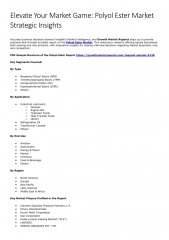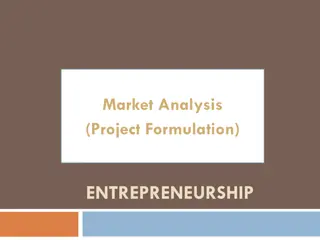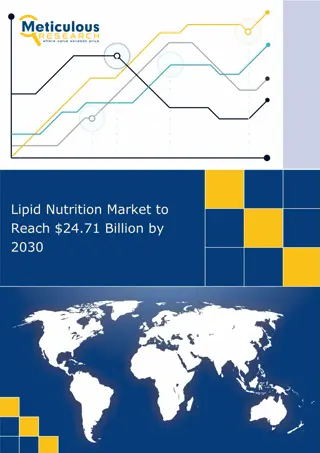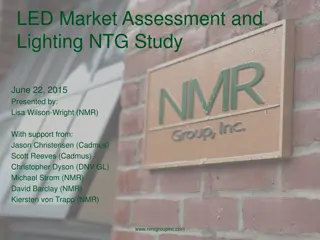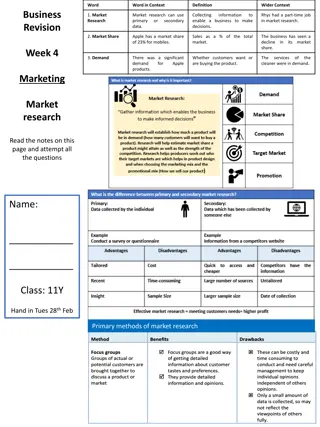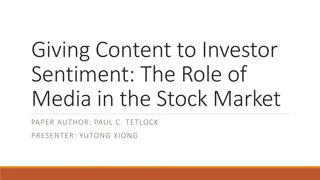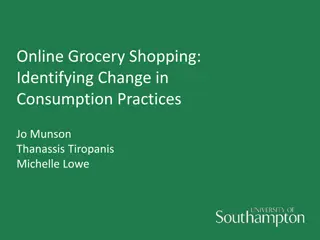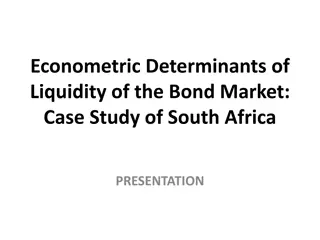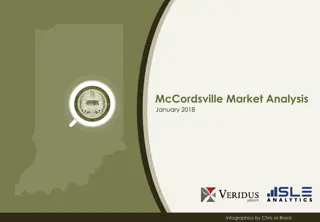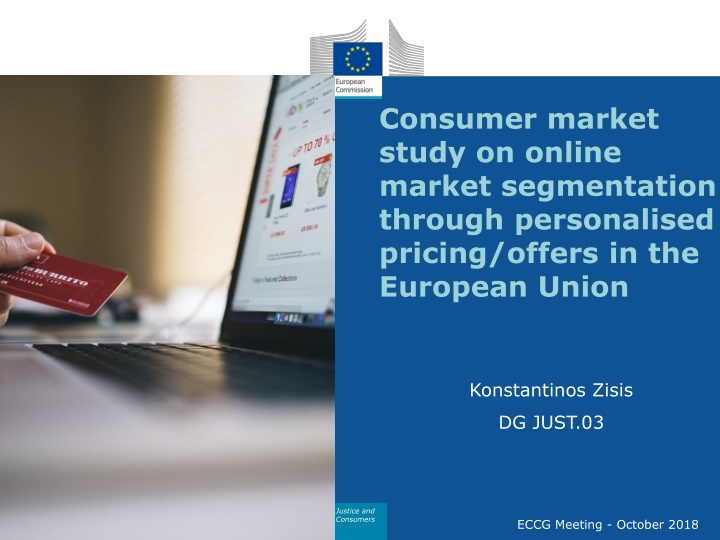
Exploring Online Market Segmentation Through Personalised Pricing in EU
Dive into a comprehensive market study on online segmentation through personalised pricing and offers in the European Union. Discover insights on consumer awareness, business transparency, and the economic impact of online personalised practices. The study encompasses a literature review, stakeholder consultations, online surveys across EU Member States, mystery shopping exercises, and behavioral experiments to gauge consumer behavior towards personalised products. Uncover the nuances of online market dynamics and consumer perceptions in this in-depth examination.
Download Presentation

Please find below an Image/Link to download the presentation.
The content on the website is provided AS IS for your information and personal use only. It may not be sold, licensed, or shared on other websites without obtaining consent from the author. If you encounter any issues during the download, it is possible that the publisher has removed the file from their server.
You are allowed to download the files provided on this website for personal or commercial use, subject to the condition that they are used lawfully. All files are the property of their respective owners.
The content on the website is provided AS IS for your information and personal use only. It may not be sold, licensed, or shared on other websites without obtaining consent from the author.
E N D
Presentation Transcript
Consumer market study on online market segmentation through personalised pricing/offers in the European Union Konstantinos Zisis DG JUST.03 Justice and Consumers ECCG Meeting - October 2018
Objectives & scope of the study The main aim was to explore: the nature and prevalence of online personalised practices (ranking of offers/pricing/targeted advertising); whether businesses are transparent about online personalisation; consumers awareness and perception of online personalised practices and problems experienced; and the economic value/effects Focus on: online firms (e-commerce sites, including marketplaces) online social media Justice and Consumers
Main research tasks (Dec. 16 - Nov. 17) a literature review of online personalised practices; consultations with stakeholders; an online survey (28 EU Member States, plus NO & IS) to measure consumers awareness of/opinions on online personalised practices; a mystery shopping exercise: 160 websites, 8 EU MS (CZ, DE, ES, FR, PL, RO, SE, UK) & 4 market sectors (TVs, sport shoes, hotels rooms and airline tickets) to assess the prevalence of personalised practices and an online behavioural experiment toassess: - consumers ability to recognise online personalisation & - their willingness to purchase personalised products, depending on the: (1) transparency in communication by the online platform & (2) impact of layout, format and information content Justice and Consumers
Mystery shopping Aim/scenarios Aim: replicate consumers real life experiences when searching online to buy products in e-commerce websites, to assess prevalence of: personalised ranking of offers personalised pricing Differences to look at 4 scenarios (A) Use of a preferred search engine (e.g. Google) vs DuckDuckGo (does not track users) to go to the same predefined e-commerce website Search engine (B) Entering the same e-commerce website via 1) a predefined price comparison website and 2) directly, by entering the URL PCW (C) Use of a preferred browser vs another browser (less used/freshly installed) Browser (D) Use of a mobile device vs desktop (used in all other scenarios) Mobile device Justice and Consumers
Mystery shopping Design All 4 scenarios were executed one after the other by each shopper 8 countries x 4 sectors x 5 websites x 4 shoppers = 640 shops In each country, 4 shoppers simultaneously accessed the same website to search for prices / rank of products in identical 3-hour time-brackets Control steps and shops to identify inconsistencies not explained by the parameter(s) for personalisation tested Control step: shoppers recorded products/prices on each website also using the browser incognito/privacy mode (e.g. as if deleting cookies) o Independent control shop: For each website visited by 4 shoppers, a subcontractor researcher carried out a simultaneous independent control shop with an anonymised browser o Justice and Consumers
Behavioural experiment: approach Set-up: Simulated online comparison tool showing ranked search results (based on the same predefined previous search history/purchase hypothesis) Participants randomly allocated to one of the following combinations: Products: Car rentals, holiday accommodation or TVs Scenarios: baseline, ranking of offers, price discrimination, targeted advertising Nodes: Browser/previous search history, high/low prices, targeted ads with ranked/no ranked results Treatments relating to communication of personalisation: o Low transparency: not made clear that results are personalised; o High transparency: salient communication that results are personalised o High transparency + action: salient communication + easy to clear cookies/search again Justice and Consumers
Literature review Justice and Consumers
Type of personal data collected Personal data can be surrendered by users (e.g. when creating accounts online), observed (e.g. browsing history tracked using cookies) or inferred (e.g. combining data collected from different sources) Online firms collect different types of personal data: socio-demo data (e.g. age, gender), behavioural (history of website visits), technical (IP ad., browser etc.) Generally transmitted in anonymised / pseudonymised form, but cannot exclude individuals being identified Online firms can target certain consumers differently, e.g. segmenting users based on their willingness to pay or on specific needs (e.g. weight loss) Justice and Consumers
Overall data ecosystem Online firms can use numerous tracking methods to follow consumers across different platforms, websites and devices Usually cookies; also lately digital fingerprinting & web beacons o Pricing algorithms increasingly used for price discrimination, as well as for dynamic pricing E-commerce websites may use specialised companies personalisation / analytics software or services (data brokers) to obtain refined consumer profiles Social media, e-commerce firms, collaborative platforms & advertising companies collect large amounts of data, combine with data via other means (e.g. market research companies) tosegment consumers Advanced tools (e.g. VPN or the TOR browser) to prevent sophisticated tracking methods rarely used by consumers Justice and Consumers
Results of the study Justice and Consumers
Evidence of online personalised ranking of offers 61% of the 160 e-commerce firms were found to practise personalised ranking of offers, either through the means of entry to a website (e.g. search engine, PCW, different browser or a mobile device) or based on the shoppers past online behaviour Access through a PCW or mobile device had the highest impact Across sectors, the share of websites employing ranked offers ranged from 92% (airline tickets), 76% (hotel rooms), 41% (sports shoes) to 36% (TVs) Across countries, the percentage of websites undertaking this practice ranged from 42% - 47% (in DE & CZ) to 75% - 79% (SE & PL) Noevidence for systematic price differences from personalised ranked offers. Small statistically significant results in individual product categories Justice and Consumers
Evidence of online personalised pricing The mystery shopping couldnot find evidence of consistent and systematic online personalised pricing across the 8 EU MS & 4 markets: Price differences between personalisation and nopersonalisation scenarios in only 6% of situations. When observed, small differences: median <1.6% Prices not systematically higher or lower in the personalisation scenarios compared to the nopersonalisation scenario Accessing an e-commerce firm via a PCW had the highest impact on prices (as much as 3% in certain cases) Airline tickets (19) and hotel booking (9) websites displayed highest level of price personalisation. Shoes (4) and TVs (2) much less Results broadly consistent with literature - extremely difficult to detect Justice and Consumers
Distribution of products with non-zero price difference In 94% of the 34,403 matched product pairs, there was no price difference at all Among the remaining 6% product pairs, the median difference is < 1.6% Justice and Consumers
Relative frequency of % price differences between matched products Price differences symmetric around the value of 0, i.e. small differences in both positive and negative directions Justice and Consumers Sample size: 2061 product matches with non-zero price difference
Evidence of online targeted advertising Different types of online targeted advertising based on collected info of shoppers online behaviour: - contextual - segmented - behavioural EUROSTAT 2016: 25% of all enterprises (>10 ppl) use internet advertising. Of these: - 78% have adopted contextual advertising & - 27% behavioural advertising (much higher for large companies) The study s findings suggest that online targeted advertising is the most widespread online personalisation practice Justice and Consumers
Consumer awareness of personalised practices Self-reported awareness (EU survey): - online targeted ads (67%) - personalised ranking of offers (62%) - personalised pricing (44%) Perceived incidence (EU survey): - online targeted ads (70%) - personalised ranking of offers (53%) - personalised pricing (28%) Self-reported awareness does not necessarily translate in ability to correctly identify online personalisation (behav. experiment) ~40% for targeted advertising, 37% forranked offers based on previous search history, 17% for price personalisation (lower prices) o Increased transparency in communication of personalisation led to increase in % of correct identification of personalised ranking of offers only: from ~29% in low transparency treatments to 40% in high transparency treatments o Justice and Consumers
Consumers concerns on online personalised practices Targeted adverts: personal data could be used for other purposes /shared with 3rd parties (49%); o their online data being collected/ a profile being made (46%); o cookies installed on their computer (27%) o Personalised ranking of offers: personal data could be used for other purposes/shared with 3rd parties (46%); o their online data being collected/ a profile being made (42%); o cookies being installed on their computer (25%) o Personalised pricing: personal data could be used for other purposes/shared with 3rd parties (36%); o their online data being collected/ a profile being made (33%); o ending up paying more (28%) o Justice and Consumers
Consumers perceived benefits of online personalised practices Targeted adverts: allowing to see interesting products (42%); reducing number of irrelevant adverts (23%); and funding free content (20%) o Personalised ranking of offers: allowing to see interesting products (34%); saving time when searching online (23%); and making it easy to choose products that suits consumers needs (23%) o Personalised reductions/promotions (22%); allowing to get the best available price for products (21%); and allowing to increase product choice (15%) pricing: allowing e-commerce websites to offer o No benefits whatsoever: 24% for targeted adverts, 25% for personalised ranking of offers, 32% for personalised pricing Justice and Consumers
Experiences & conditions for improvement Bad experience(s) with personalised practices: 18% for online targeted adverts, 14% for personalised ranked offers, 12% for personalised pricing No.1 bad experience (50%): been offered a product not/no longer interested I would be more positive It would make no difference for me I would be more negative Don t know EU28 If I would have an easy option to opt-out of personalised practices 62 21 5 11 If it was explained what personal data is collected on me 55 25 10 10 If I was able to see/change my personal data used for such practices 55 25 8 12 If it was explained for what purpose my personal data is collected 53 28 8 10 If it was explained which 3rd parties access my personal data 52 24 14 10 If I was informed when targeted adverts or personalised pricing/offers are shown to me 47 33 8 12 If I was informed why a particular advert or a particular search result/price was shown to me 47 34 8 12 Justice and Consumers 0 10 20 30 40 50 60 70 80 90 100
Influence of personalisation on consumer decisions Personalisation practices & transparency in communication: No statistically significant impact on purchasing (72% chose to purchase a product) The type of personalised practice had an impact on the probability that a personalised product was selected: o targeted advertising with ranked offers: 62% of participants chose to purchase a personalised product (vs 50% in the baseline scenario) o price discrimination scenario with lower prices: 66% Higher transparency + easier to clear cookies: less people chose to switch to another platform (26% vs 34% in low transparency treatment) Overall, 2.7% chose to clear cookies & search again. But 7.2% in the high transparency treatment where clearing cookies was easy in a 1-way step Justice and Consumers
Economic effects of online personalisation Existing literature: - behaviourally targeted advertising: fivefold increase in % of website visitors who complete a transaction - online personalisation: benefits consumers if it shows products that best suit their needs, lowers prices or reduces search costs. Can benefit tech- savvy consumers - negative effect for consumers if steered towards the most expensive products. May harm those not able/willing to search or with high willingness-to-pay Market competitiveness: intense competition personalisation can benefit consumers - sellers can compete with each other to adapt prices weak competition personalisation helps sellers to extract more surplus Wider long-term impacts: personalisation can limit range of products available to consumers - barriers to competition / innovation Justice and Consumers
Study published 17 July 2018 https://ec.europa.eu/info/publications/consumer- market-study-online-market-segmentation- through-personalised-pricing-offers-european- union_en Konstantinos.Zisis@ec.europa.eu Thanks for attending ! Justice and Consumers

